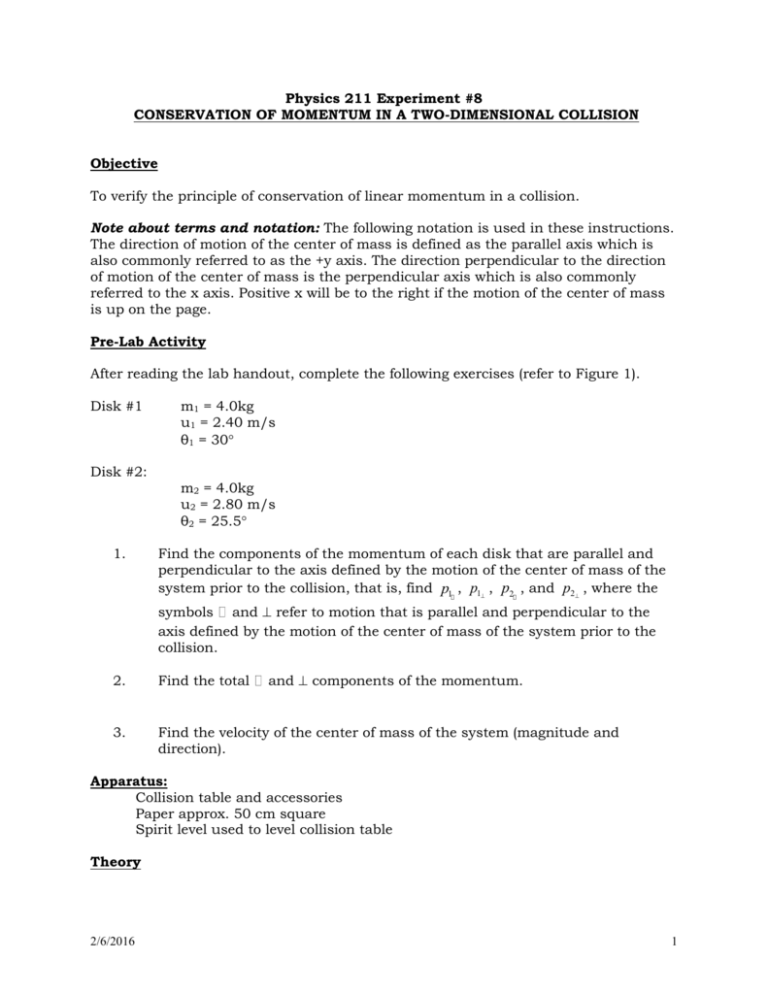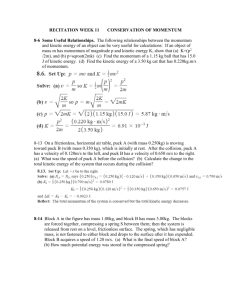CONSERVATION OF MOMENTUM IN A TWO
advertisement

Physics 211 Experiment #8 CONSERVATION OF MOMENTUM IN A TWO-DIMENSIONAL COLLISION Objective To verify the principle of conservation of linear momentum in a collision. Note about terms and notation: The following notation is used in these instructions. The direction of motion of the center of mass is defined as the parallel axis which is also commonly referred to as the +y axis. The direction perpendicular to the direction of motion of the center of mass is the perpendicular axis which is also commonly referred to the x axis. Positive x will be to the right if the motion of the center of mass is up on the page. Pre-Lab Activity After reading the lab handout, complete the following exercises (refer to Figure 1). Disk #1 Disk #2: 1. m1 = 4.0kg u1 = 2.40 m/s θ1 = 30 m2 = 4.0kg u2 = 2.80 m/s θ2 = 25.5 Find the components of the momentum of each disk that are parallel and perpendicular to the axis defined by the motion of the center of mass of the system prior to the collision, that is, find p1 , p1 , p2 , and p2 , where the symbols and refer to motion that is parallel and perpendicular to the axis defined by the motion of the center of mass of the system prior to the collision. and components of the momentum. 2. Find the total 3. Find the velocity of the center of mass of the system (magnitude and direction). Apparatus: Collision table and accessories Paper approx. 50 cm square Spirit level used to level collision table Theory 2/6/2016 1 The principle of conservation of linear momentum states that the total vector momentum of a system will be the same, in magnitude and direction, after a collision as it was before the collision, as long as the net external force on the system is zero during the collision. That is, the total momentum of the system is conserved when the net external force is zero. Collisions for which the total kinetic energy is also conserved (i.e. remains the same) are called elastic collisions. All other collisions are inelastic. In inelastic collisions, the total kinetic energy is less after the collision, with the lost kinetic energy being converted to heat. Direction of 1 v1 vcm 2 v2 v2 v1 v2 v1 2 1 Direction to vcm 1 1 u1 P1 u1 2 u2 u2 u 2 P2 u1 Figure 1a. A diagram of the velocity vectors and the coordinate system for a two dimensional collision. P1 and P2 are the initial positions of m1 and m2. Figure 1 shows two point masses before and after a collision. u1 velocity of mass #1 before collision u2 velocity of mass #2 before collision v1 velocity of mass #1 after collision v 2 velocity of mass #2 after collision 2/6/2016 2 Conservation of linear momentum implies before pi p i after p 1 p 2 before p 1 p 2 after m1u1 m2u2 m1v1 m2 v 2 (1) This vector equation represents two equations, one for the and one for the components of the linear momentum. To simplify analysis of the collision, the axis is chosen as the line of motion of the center of mass of the system (as shown in Figure 1), and the axis is perpendicular to this motion. The system’s total momentum ( P p i ) before the collision can also be expressed in terms of the motion of the center of mass as Pbefore Mvcm before (4) where M m1 m2 and v cm before is the center of mass velocity before the collision. Since Pbefore Pafter Mv cm before Mv cm after Then (5) v cm before v cm after since the masses m1 and m2 are equal. Thus, the velocity of the center of mass of the system before and after the collision are equal in both magnitude and direction for an elastic collision. 2/6/2016 3 Figure 2. The two dimensional collision apparatus is shown. The air compressor and the foot pedal are beneath the table. Description of the Apparatus The apparatus is shown in Figure 2. The two disks can move without friction along the horizontal surface due to air cushions under the disks. A thin air cushion is produced by air pumped under pressure down a plastic tube attached to the center of each disk. A small metal chain inside each plastic tube can carry an electric spark. When the foot pedal is pressed down, sparks travel down each chain and through a sparksensitive paper lying on the horizontal metal surface, marking the location of the center of each disk. The interval between sparks is set at 30 ms. The desired result is a spark paper with a set of dots showing the motion of the two disks before and after the collision (see Figure 3.) 2/6/2016 4 After Collision After Collision. The dashed line with arrow is the direction of motion of the center of mass before collision 1 1 Before Collision Figure 3a. Spark paper data for a typical collision. Dots are circled as in step 3 of the procedure. 2 2 Before Collision Figure 3b. The lines drawn for the direction of motion of finite size masses colliding. Note that the pattern is not a neat ‘X” figure. The figure shows the angles made relative to the direction of motion of the center of mass. Procedure 1. Each lab group will make or be provided with a sample of spark paper showing the motion of the two disks before and after their collision. Note: The time between sparks is 30 ms and the mass of each disk is 560 g. IF YOU MAKE THE SPARK PAPER TRACK YOUSELF, BE SURE YOU UNDERSTAND HOW TO USE THE APPARATUS CORRECTLY WITHOUT GETTING A SHOCK. Practice starting the disks a few times until you can cause a suitable collision. BE SURE TO HOLD THE INSULATED TUBING ABOVE THE METAL DISKS AND DO NOT TOUCH THE DISKS WITH ANY PART OF YOUR HAND! After you make your sample, check that there are at least eleven dots equally spaced before and after the collision for each disk. Then place the spark paper on your lab table and take measurements as follows. 2. 2/6/2016 Determine where the impact occurred by drawing straight lines through the rows of dots to represent the initial and final paths of each body. Note that a spark may not have occurred at the time of impact. 5 3. For the first dot before impact draw a straight line connecting the positions of the two bodies. Do the same for the eleventh dot before impact, and for the first and eleventh dot after impact. Mark the midpoints of these lines. The midpoints represent the position of the center of mass of the system as the bodies moved (since the bodies have equal mass.) 4. Measure the distance along each disk’s path before and after the collision, from the first to the eleventh dot. 5. Connect the two center of mass points before the collision and extend this line across the page. Label this as the axis. 6. Measure the angle of each disk’s path before the collision (1 and 2) with respect to the axis. Also measure the angle of each path after the collision (1 and 2 ) with respect to the axis. 7. Measure the distance between the two center of mass points before the collision, and also between the two center of mass points after the collision. 8. Measure the angle, if any, between the direction of motion of the center of mass before and after the collision. 9. Assume the masses of the disks are the same, which is a pretty good assumption, with mass per disk of 560g. Calculations A. Conservation of Momentum 1. From the distance measurements along the paths of the disks (procedure step 4), calculate the velocity of each body before and after the collision, using the relation: velocity = distance/time. 2. Calculate the components of the momentum for each disk before and after the collision. Determine the total momentum before and after the collision Find the percent difference between the total momentum before and after collision. Calculate the % difference. Does the result match theoretical expectations? 3. Calculate the components of the momentum for each disk before and after the collision. Determine the total momentum before and after the collision. Do the results match theoretical expectations? 2/6/2016 6 B. Center of Mass Motion 4. C. Elastic or Inelastic Collision? 5. 2/6/2016 From the measurements of the center of mass points (steps 7 and 9 of the procedure), find the momentum of the center of mass before and after the collision, and the percent difference between them. Does the result match theoretical expectations? Calculate the total kinetic energy of each mass before and after the collision and determine whether the collision was elastic or inelastic. 7









